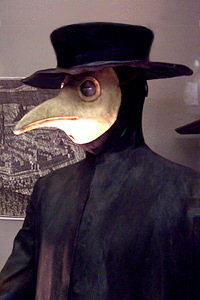
Personal protective equipment (PPE) is protective clothing, helmets, goggles, or other garments or equipment designed to protect the wearer's body from injury or infection. The hazards addressed by protective equipment include physical, electrical, heat, chemical, biohazards, and airborne particulate matter. Protective equipment may be worn for job-related occupational safety and health purposes, as well as for sports and other recreational activities. Protective clothing is applied to traditional categories of clothing, and protective gear applies to items such as pads, guards, shields, or masks, and others. PPE suits can be similar in appearance to a cleanroom suit.
Plague or The Plague may refer to:
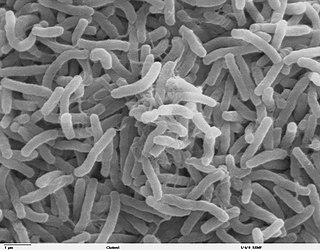
The germ theory of disease is the currently accepted scientific theory for many diseases. It states that microorganisms known as pathogens or "germs" can cause disease. These small organisms, too small to be seen without magnification, invade humans, other animals, and other living hosts. Their growth and reproduction within their hosts can cause disease. "Germ" refers to not just a bacterium but to any type of microorganism, such as protists or fungi, or other pathogens that can cause disease, such as viruses, prions, or viroids. Diseases caused by pathogens are called infectious diseases. Even when a pathogen is the principal cause of a disease, environmental and hereditary factors often influence the severity of the disease, and whether a potential host individual becomes infected when exposed to the pathogen. Pathogens are disease-carrying agents that can pass from one individual to another, both in humans and animals. Infectious diseases are caused by biological agents such as pathogenic microorganisms as well as parasites.

A mask is an object normally worn on the face, typically for protection, disguise, performance, or entertainment, and often employed for rituals and rites. Masks have been used since antiquity for both ceremonial and practical purposes, as well as in the performing arts and for entertainment. They are usually worn on the face, although they may also be positioned for effect elsewhere on the wearer's body.

A plague doctor was a physician who treated victims of bubonic plague during epidemics mainly in the 16th and 17th centuries. These physicians were hired by cities to treat infected patients regardless of income, especially the poor, who could not afford to pay.

A hazmat suit is a piece of personal protective equipment that consists of an impermeable whole-body garment worn as protection against hazardous materials.
In epidemiology, case fatality rate (CFR) – or sometimes more accurately case-fatality risk – is the proportion of people who have been diagnosed with a certain disease and end up dying of it. Unlike a disease's mortality rate, the CFR does not take into account the time period between disease onset and death. A CFR is generally expressed as a percentage. It is a measure of disease lethality, and thus may change with different treatments. CFRs are most often used for with discrete, limited-time courses, such as acute infections.

The Carnival of Venice is an annual festival held in Venice, Italy, famous throughout the world for its elaborate costumes and masks. The Carnival ends on Shrove Tuesday, which is the day before the start of Lent on Ash Wednesday.

Jean-Jacques Manget (1652–1742) was a Genevan physician and writer. He was known for his work on epidemic diseases such as bubonic plague and tuberculosis. In addition to his own researches, he assiduously compiled preceding medical literature. With Théophile Bonet, he is considered one of the "great compilers" of knowledge in the areas of medicine, surgery and pharmacology. He also published a major collection of alchemical works, the Bibliotheca Chemica Curiosa (1702).

Bubonic plague is one of three types of plague caused by the bacterium Yersinia pestis. One to seven days after exposure to the bacteria, flu-like symptoms develop. These symptoms include fever, headaches, and vomiting, as well as swollen and painful lymph nodes occurring in the area closest to where the bacteria entered the skin. Acral necrosis, the dark discoloration of skin, is another symptom. Occasionally, swollen lymph nodes, known as "buboes", may break open.

In health care facilities, isolation represents one of several measures that can be taken to implement in infection control: the prevention of communicable diseases from being transmitted from a patient to other patients, health care workers, and visitors, or from outsiders to a particular patient. Various forms of isolation exist, in some of which contact procedures are modified, and others in which the patient is kept away from all other people. In a system devised, and periodically revised, by the U.S. Centers for Disease Control and Prevention (CDC), various levels of patient isolation comprise application of one or more formally described "precaution".
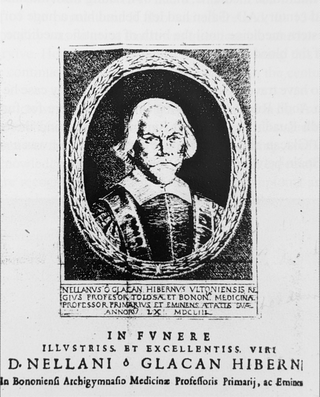
Niall Ó Glacáin, sometimes anglicised as Nial O'Glacan was an Irish physician and plague doctor who worked to treat victims of bubonic plague outbreaks throughout continental Europe. He was a physician to Hugh Roe O'Donnell and King Louis XIII.
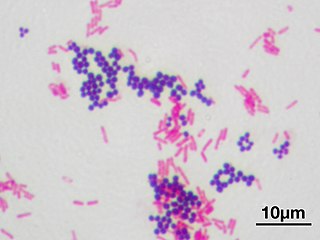
Infectious diseases (ID), also known as infectiology, is a medical specialty dealing with the diagnosis and treatment of infections. An infectious diseases specialist's practice consists of managing nosocomial (healthcare-acquired) infections or community-acquired infections. An ID specialist investigates and determines the cause of a disease. Once the cause is known, an ID specialist can then run various tests to determine the best drug to treat the disease. While infectious diseases have always been around, the infectious disease specialty did not exist until the late 1900s after scientists and physicians in the 19th century paved the way with research on the sources of infectious disease and the development of vaccines.

Pierre-Jean Fabre was a French doctor and alchemist. Born in Castelnaudary, France in 1588, he studied medicine in Montpellier, France. He became a practitioner of the iatrochemical medicine of Paracelsus. Beginning in 1610 he practiced medicine in Castelnaudary. He became famous as a specialist in the plague which was particularly severe in central Europe during the Thirty Years' War. Fabre prescribed chemical medications for the treatment of the plague and was at one time the private physician of King Louis XIII of France.

The Plague of Ashdod is also known as The Miracle of the Ark in the Temple of Dagon, by the French artist Nicolas Poussin. The painting represents a story from 1 Samuel in the Old Testament. The original painting currently hangs in the Louvre in Paris. Poussin was commissioned to paint The Plague of Ashdod by Fabrizio Valguarnera. Fabrizio Valguarnera was a Sicilian merchant who was put on trial for laundering money through the purchase of this painting; he also commissioned more than one version of this piece. Poussin painted this during a plague that took place in Italy from 1629 to 1631, which influenced his accurate portrayal of the epidemic.

A cloth face mask is a mask made of common textiles, usually cotton, worn over the mouth and nose. When more effective masks are not available, and when physical distancing is impossible, cloth face masks are recommended by public health agencies for disease "source control" in epidemic situations to protect others from virus laden droplets in infected mask wearers' breath, coughs, and sneezes. Because they are less effective than N95 masks, surgical masks, or physical distancing in protecting the wearer against viruses, they are not considered to be personal protective equipment by public health agencies. They are used by the general public in household and community settings as protection against both infectious diseases and particulate air pollution.

Medical gowns are hospital gowns worn by medical professionals as personal protective equipment (PPE) in order to provide a barrier between patient and professional. Whereas patient gowns are flimsy often with exposed backs and arms, PPE gowns, as seen below in the cardiac surgeon photograph, cover most of the exposed skin surfaces of the professional medics.
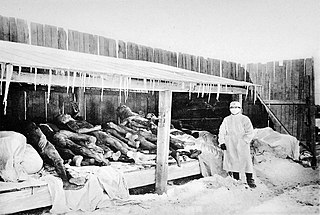
The Manchurian plague was a pneumonic plague that occurred mainly in Manchuria in 1910–1911. It killed 60,000 people, stimulating a multinational medical response and the wearing of the first personal protective equipment (PPE).
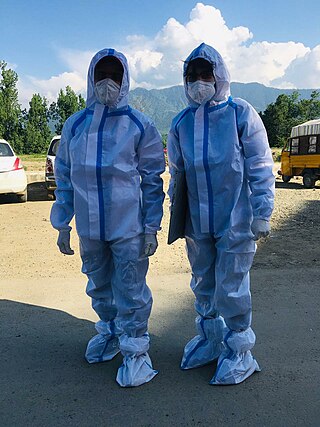
Medical textiles are numerous fiber-based materials intended for medical purposes. Medical textile is a sector of technical textiles that emphasizes fiber-based products used in health care applications such as prevention, care, and hygiene.

